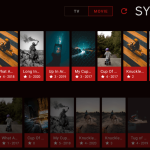The image depicted in the link above is an illustration of a guide for beginners on TV streaming which was published by allconnect in 2019.
There are numerous incentives to incorporate streaming into your television viewing habits whether its to catch up on the newest season of stranger things or to avoid high cable bills. In todays world streaming platforms offer all the features of traditional cable such as live TV on demand content and even DVR options at a more affordable monthly cost.
Streaming has become an essential part of watching TV making it difficult to do so without a streaming service. According to a recent study by Deloitte 2018 saw more original scripted TV shows being released on streaming platforms than on broadcast and basic cable. Additionally the study found that a larger number of American consumers are now subscribed to a streaming service compared to traditional TV subscriptions, as reported by Allconnect.
According to statistics video streaming platforms are the top choice for subscription based streaming services with a staggering 78% of households in the United States having at least one or more subscriptions. This represents a significant increase of 52% since 2015.
The abundance of streaming services available in the U.S. can be daunting if you are not already a part of the trend. With over 200 options to choose from (according to some sources) it is natural to wonder what streaming actually is. Here is a brief overview to help you understand.
All the essentials for getting started with streaming
Although streaming television may appear complex, you likely have all the necessary resources in your own home. And if not, you shouldn’t have to spend more than $50 to get started.
High-speed internet
The key to a satisfying streaming experience lies in your internet service provider. Our handbook on internet speeds suggests different minimum requirements for various streaming activities.
For streaming videos in SD, it is recommended to have a minimum of 3 Mbps. For streaming videos in HD, the recommended minimum is 5 Mbps. If you want to stream videos in HDR or 4K, it is recommended to have at least 25 Mbps.
The following is a guide to paraphrasing text to eliminate any instances of plagiarism. This can be achieved by altering the structure of the text while still maintaining the original meaning and context. It is important to preserve the markdown formatting when paraphrasing.
The following text has been rephrased to eliminate any instances of plagiarism by altering the arrangement of the sentences while maintaining the original meaning. The format of the text has been retained.
The given passage has been restated in order to eliminate any potential plagiarism by modifying the sentence structure while preserving the intended message. the original formatting of the text has been maintained.
Uncertain about the type of streaming you will be engaging in? It is highly likely that it will be in HD.
SD (Standard Definition) resolution is now considered outdated. streaming videos in SD quality which is equivalent to 480p consumes approximately 0.7 GB of data per hour. The last time a TV show was aired in SD was in 2014 and since then most TVs have been produced in HD instead of SD. This change to HD began around 2009 when the FCC required all TV signals to be transmitted digitally.
In the present day, there is no production of SD TVs and Netflix stands as the sole major streaming service that provides an SD plan, primarily to advertise its more affordable starting rate.
4K televisions are situated at the other extreme of the range. They offer the highest quality display that can be purchased with money which in turn, places a greater demand on your internet connection. This type of video consumes the maximum amount of data at 7.2 gigabytes per hour but it does offer the top level of quality possible.
The majority of televisions are currently classified as HD, which falls in between SD and Ultra HD or 4K. For every hour of use, it consumes 0.9 GB to 3 GB of data. It is recommended to have a minimum of 5 Mbps download speed, but this may need to be increased if multiple devices are connected simultaneously. To determine your current speed, you can use our speedtest tool below.
Expert Suggestion: To achieve optimal outcomes, it is recommended to utilize an Ethernet cord and directly connect your device to the router or modem prior to running the test.
Device for streaming, smart TV, or gaming console
After obtaining a sufficiently speedy internet connection, you will require a means of streaming on your television. There are three typical methods to achieve this:
Devices for streaming content, such as Roku and Amazon Fire TV, have a price range of $40 and can be plugged into the HDMI port of your TV. They offer access to a wide range of streaming services. The variety of streaming apps available is the main attraction as these devices provide access to services like HBO Now, which may not be available on your smart TV. Additionally, they have a user-friendly interface and the ability to search for specific titles across all streaming services.
Smart TVs are the most commonly used method by Americans for streaming content, with 31% of people using this method according to Tivos Q1 2020 Video Trends Report. If you have purchased a TV in the last decade, chances are it is a smart TV, meaning it can connect to the internet and has pre installed streaming apps. However these TVs may not have all the apps you desire and there is often no option to add new ones.
Gaming consoles are also a popular method for streaming content but they are primarily used for gaming. if you do not already own a gaming console it is not worth spending over $300 just for streaming purposes.
Is a streaming device necessary for a smart TV?
There are a couple of main benefits to utilizing a streaming device instead of relying on the pre installed choices on your intelligent TV. Firstly you will have a wider range of streaming services to choose from. Additionally, the interface and search system will be more user friendly making it easier for you to navigate and find what you are looking for.
A number of smart TVs are equipped with a limited selection of pre installed streaming apps leaving no room for additional ones. In the event that you wish to stream Mulan but the Disney+ app is not available on your TV you would not be able to do so.
Streaming devices offer a more efficient system for managing all of your streaming apps. They simplify the process of switching between services and enable you to search for titles across all available apps on the device. This eliminates the need to spend time browsing through individual apps and potentially wasting money on renting a movie that is already included in one of your subscriptions.
Tips for streaming without an HDMI port
If you own an older SD TV without HDMI ports you can still stream content by using the appropriate equipment. one option is to use the Roku Express+ which is the only streaming device made by roku that is compatible with the red yellow and white composite jacks commonly found on older TVs.
To utilize various streaming devices, you have the option to buy an HDMI to RCA adapter to convert your TV. However, there have been reports about its ineffectiveness with streaming services. Therefore, we suggest choosing Roku as a more suitable option for older TVs.
Steps to Begin Live Streaming
Step 1: Connect your streaming device
If you happen to have a smart TV you can proceed directly to the second step. Most streaming devices can be connected to your TV through its HDMI port and typically require a power source as well. The initial step is to plug in the device, switch your TV to the designated HDMI input, and then follow the on screen instructions.
Step 2: Establish an internet connection
After connecting your streaming device you will be required to log in to your homes Wi-Fi network. Certain devices such as Amazons Fire TV Stick 4K and Googles Chromecast Ultra, have the capability to directly connect to your modem via an Ethernet cable. This typically offers a more dependable connection resulting in minimal buffering while streaming.
Step 3: Log into streaming services
Commonly used streaming platforms such as Netflix and Hulu are typically already installed on your streaming device or smart TV. However if you wish to access a specialized service like shudder or the criterion channel you will likely need to manually download it.
Discover the perfect streaming platform
In the world of streaming television there are two primary types of services to choose from: live and on demand. live streaming functions similarly to a cable subscription offering the same channels and advertisements but at a higher cost compared to other options on the other hand on demand streaming services like Hulu and Netflix do not include any live programming allowing viewers to watch their shows and films at their convenience.
Streaming on Demand
By far, these are the most popular type of streaming services. Typically priced at $10 per month, they also include a seven day free trial and provide access to a vast collection of TV shows and movies. Below are some of the most widely used combinations:
Streaming bundle| Cost
Disney Plus, Hulu and ESPN+ bundle| $12.99 per month
Netflix Standard and Hulu with advertisements| $23.48 per month
Netflix Standard and Disney Plus| $23.48 per month
Netflix Standard, Prime Video and Hulu with advertisements| $32.47 per month
Netflix Standard, Prime Video and Max| $34.47 per month
The monthly cost excluding taxes will depend on the duration of the contract. additional charges and conditions may be applicable. The pricing may differ depending on the location and availability. All prices are subject to alteration at any given time. the service may or may not be accessible based on the service address. The speed of the service may also vary As of 06/26/23.
Streaming Live TV
Streaming live TV through your internet connection is a common service known as cable replacements. These services usually have a price of $50 per month and are often considered a more affordable option compared to traditional cable. One advantage of these services is that they operate on a month to month basis allowing for easy cancellation if the customer is dissatisfied. Popular examples of live TV streaming services include YouTube TV and Hulu + Live TV both of which are discussed in our comparison review YouTube TV vs Hulu + Live TV.
Streaming services at no cost
Although streaming services are often marketed as a more affordable option compared to traditional TV costs can still add up quickly. Thankfully there are numerous free streaming services with surprisingly good content selections. while there may be some advertisements to sit through it is still significantly less than what you would experience with cable.
A few streaming services that are available for free are:
-
- Pluto TV – Offers a selection of live TV channels
-
- Tubi TV – Features exclusive, original content
-
- Peacock – Provides both live TV and original content
-
- **Roku Channel – **
-
- Freevee – Offers a mix of live TV and unique content
-
- Crackle – Presents exclusive, original content
-
- Roku Channel – Provides a combination of live TV and original content
- Sling Freestream – Features original content for viewers to enjoy.
Well-known streaming platforms
Netflix – Netflix offers four different plans including basic with ads, basic standard and premium with prices ranging from $6.99 to $19.99 per month. The streaming service boasts a vast collection of original content, including popular titles such as stranger things the crown Bridgerton, Black Mirror and glass onion.
**Max- previously known as HBO Max, Max is a streaming service provided by HBO and is highly favored among users. Max offers three subscription plans: With commercials without commercials and Ultimate Ad free with prices ranging from $9.99 to $19.99 per month. Max boasts a vast collection of over 35,000 hours of content, including its impressive original productions such as Game of Thrones Euphoria and The Last of Us TV series.
Hulu offers two plans: one with ads for $7.99 per month and one without ads for $14.99 per month. For a bundled package you can get Hulu, Live TV, Disney+, and ESPN+ for $69.99 to $82.99 per month. Compared to other streaming services Hulu stands out with its Live TV option, which has a wide range of channels and excellent DVR capabilities. On the on demand side, Hulu has a strong collection of original content and popular TV shows and movies such as The Handmaids Tale and The Great and Only Murders in the Building.
Disney+ is a streaming platform owned by Disney, featuring a variety of content from Pixar, Marvel, Star Wars and National Geographic. It offers two subscription plans at $7.99/month with ads and $10.99/month for an ad free experience. Additionally there are Disney bundle options available, including the duo basic bundle at $9.99/month which includes Hulu and Disney+ with ads the trio basic bundle at $12.99/month which includes Hulu, Disney, and ESPN+ with ads, and the Trio Premium bundle at $19.99/month which includes Hulu, Disney+, and ESPN+ with no ads.
Streaming services provide greater flexibility compared to traditional cable television as you have the ability to access it on multiple devices. You can easily enjoy these applications on your mobile phone or tablet and even on the go by downloading content to watch offline.
Streaming options suitable for families and children
For those seeking child friendly options streaming platforms such as Netflix, Hulu, prime video, Disney+, and Max offer various features like parental controls content filtering and individual profiles for kids. These platforms also provide content libraries specifically designed for children. Additionally this guide can help set up parental controls on the internet.
Resolving Common Problems with Streaming
Issues commonly encountered while streaming:
Solving Buffering Issues – Buffering can occur due to a variety of reasons such as a sluggish internet connection network overload or device restrictions. To resolve this issue one can try pausing and resuming the video playback clearing the cache or cookies or switching to a lower video resolution.
Low video resolution – Insufficient internet bandwidth, streaming application preferences, or device limitations and connection problems may result in poor video quality. This can be resolved by verifying the internet speed modifying the video resolution settings in the streaming app or connecting to a more reliable Wi-Fi network.
Problems with Connection/Network – Issues with connectivity refer to instances where your Wi-Fi signal becomes weak interference from other networks or problems with your routers settings. to resolve these problems try restarting your router moving closer to the Wi-Fi source or using a wired connection for a more stable streaming experience.
Compatibility and Device Support – Resolving compatibility problems between streaming applications and devices particularly when utilizing outdated or less popular devices can be achieved by updating firmware or operating systems reviewing compatibility lists for apps or utilizing alternative streaming devices.
Troubleshooting App Crashes and Freezing – If you encounter issues such as app crashes, freezing, or unresponsiveness while streaming, try the following steps: close and reopen the app, update it to the most recent version, or clear its cache and data.
Device or Account-Related Problems – Certain streaming problems may be specific to particular devices or operating systems, such as smart TVs, gaming consoles, or mobile devices. If you encounter such issues, you can reach out to customer support, browse through customer support websites or forums, and join online communities for troubleshooting tips and guidance.






Leave a Reply